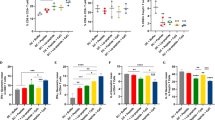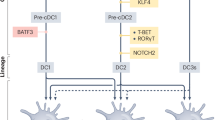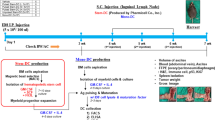Abstract
Dendritic cells (DCs) loaded with tumour antigens have been successfully used to induce protective tumour immunity in murine models and human trials. However, it is still unclear which DC administration route elicits a superior therapeutic effect. Herein, we investigated the vaccine efficiency of DC2.4 cells, a murine dendritic cell line, pulsed with ovalbumin (OVA) in the murine E.G7-OVA tumour model after immunization via various routes. After a single vaccination using 1 × 106 OVA-pulsed DC2.4 cells, tumour was completely rejected in the intradermally (i.d.; three of four mice), subcutaneously (s.c.; three of four mice), and intraperitoneally (i.p.; one of four mice) immunized groups. Double vaccinations enhanced the anti-tumour effect in all groups except the intravenous (i.v.) group, which failed to achieve complete rejection. The anti-tumour efficacy of each immunization route was correlated with the OVA-specific cytotoxic T lymphocyte (CTL) activity evaluated on day 7 post-vaccination. Furthermore, the accumulation of DC2.4 cells in the regional lymph nodes was detected only in the i.d.-and s.c.-injected groups. These results demonstrate that the administration route of antigen-loaded DCs affects the migration of DCs to lymphoid tissues and the magnitude of antigen-specific CTL response. Furthermore, the immunization route affects vaccine efficiency. © 2001 Cancer Research Campaign http://www.bjcancer.com
Similar content being viewed by others
Article PDF
Change history
16 November 2011
This paper was modified 12 months after initial publication to switch to Creative Commons licence terms, as noted at publication
References
Alters SE, Gadea JR, Sorich M, O'Donoghue G, Talib S and Philip R (1998) Dendritic cells pulsed with CEA peptide induce CEA-specific CTL with restricted TCR repertoire. J Immunother 21: 17–26
Arthur JF, Butterfield LH, Roth MD, Bui LA, Kiertscher SM, Lau R, Dubinett S, Glaspy J, McBride WH and Economou JS (1997) A comparison of gene transfer methods in human dendritic cells. Cancer Gene Ther 4: 17–25
Ashley DM, Faiola B, Nair S, Hale LP, Bigner DD and Gilboa E (1997) Bone marrow-generated dendritic cells pulsed with tumour extracts or tumour RNA induce antitumour immunity against central nervous system tumours. J Exp Med 186: 1177–1182
Austyn JM, Kupiec-Weglinski JW, Hankins DF and Morris PJ (1988) Migration patterns of dendritic cells in the mouse. Homing to T cell-dependent areas of spleen, and binding within marginal zone. J Exp Med 167: 646–651
Banchereau J and Steinman RM (1998) Dendritic cells and the control of immunity. Nature 392: 245–252
Bernhard H, Disis ML, Heimfeld S, Hand S, Gralow JR and Cheever MA (1995) Generation of immunostimulatory dendritic cells from human CD34+ hematopoietic progenitor cells of the bone marrow and peripheral blood. Cancer Res 55: 1099–1104
Brossart P, Grunebach F, Stuhler G, Reichardt VL, Mohle R, Kanz L and Brugger W (1998) Generation of functional human dendritic cells from adherent peripheral blood monocytes by CD40 ligation in the absence of granulocyte-macrophage colony-stimulating factor. Blood 92: 4238–4247
Celluzzi CM, Mayordomo JI, Storkus WJ, Lotze MT and Falo, Jr LD (1996) Peptide-pulsed dendritic cells induce antigen-specific CTL-mediated protective tumour immunity. J Exp Med 183: 283–287
Cikes M, Friberg, Jr S and Klein G (1973) Progressive loss of H-2 antigens with concomitant increase of cell-surface antigen(s) determined by Moloney leukemia virus in cultured murine lymphomas. J Natl Cancer Inst 50: 347–362
Eggert AA, Schreurs MW, Boerman OC, Oyen WJ, de Boer AJ, Punt CJ, Figdor CG and Adema GJ (1999) Biodistribution and vaccine efficiency of murine dendritic cells are dependent on the route of administration. Cancer Res 59: 3340–3345
Fallarino F, Uyttenhove C, Boon T and Gajewski TF (1999) Improved efficacy of dendritic cell vaccines and successful immunization with tumour antigen peptide-pulsed peripheral blood mononuclear cells by coadministration of recombinant murine interleukin-12. Int J Cancer 80: 324–333
Fearnley DB, McLellan AD, Mannering SI, Hock BD and Hart DN (1997) Isolation of human blood dendritic cells using the CMRF-44 monoclonal antibody: implications for studies on antigen-presenting cell function and immunotherapy. Blood 89: 3708–3716
Gong J, Chen D, Kashiwaba M and Kufe D (1997) Induction of antitumour activity by immunization with fusions of dendritic and carcinoma cells. Nat Med 3: 558–561
Harding CV (1994) Techniques for studying phagocytic processing of bacteria for class I or II MHC-restricted antigen recognition by T lymphocytes. Methods Cell Biol 45: 313–326
Hayashi A, Nakanishi T, Kunisawa J, Kondoh M, Imazu S, Tsutsumi Y, Tanaka K, Fujiwara H, Hamaoka T and Mayumi T (1999) A novel vaccine delivery system using immunopotentiating fusogenic liposomes. Biochem Biophys Res Commun 261: 824–828
Henkart PA (1994) Lymphocyte-mediated cytotoxicity: two pathways and multiple effector molecules. Immunity 1: 343–346
Hsu FJ, Benike C, Fagnoni F, Liles TM, Czerwinski D, Taidi B, Engleman EG and Levy R (1996) Vaccination of patients with B-cell lymphoma using autologous antigen-pulsed dendritic cells. Nat Med 2: 52–58
Janik P, Briand P and Hartmann NR (1975) The effect of estrone-progesterone treatment on cell proliferation kinetics of hormone-dependent GR mouse mammary tumours. Cancer Res 35: 3698–3704
Kronenberg M, Siu G, Hood LE and Shastri N (1986) The molecular genetics of the T-cell antigen receptor and T-cell antigen recognition. Annu Rev Immunol 4: 529–591
Lappin MB, Weiss JM, Delattre V, Mai B, Dittmar H, Maier C, Manke K, Grabbe S, Martin S and Simon JC (1999) Analysis of mouse dendritic cell migration in vivo upon subcutaneous and intravenous injection. Immunology 98: 181–188
Lodge PA, Jones LA, Bader RA, Murphy GP and Salgaller ML (2000) Dendritic cell-based immunotherapy of prostate cancer: immune monitoring of a phase II clinical trial. Cancer Res 60: 829–833
Ludewig B, Ochsenbein AF, Odermatt B, Paulin D, Hengartner H and Zinkernagel RM (2000) Immunotherapy with dendritic cells directed against tumour antigens shared with normal host cells results in severe autoimmune disease. J Exp Med 191: 795–803
Lutz MB, Kukutsch N, Ogilvie AL, Rossner S, Koch F, Romani N and Schuler G (1999) An advanced culture method for generating large quantities of highly pure dendritic cells from mouse bone marrow. J Immunol Methods 223: 77–92
Machy P, Serre K and Leserman L (2000) Class I-restricted presentation of exogenous antigen acquired by Fcgamma receptor-mediated endocytosis is regulated in dendritic cells. Eur J Immunol 30: 848–857
Mayordomo JI, Zorina T, Storkus WJ, Zitvogel L, Celluzzi C, Falo LD, Melief CJ, Ildstad ST, Kast WM, Deleo AB and Lotze MT (1995) Bone marrow-derived dendritic cells pulsed with synthetic tumour peptides elicit protective and therapeutic antitumour immunity. Nat Med 1: 1297–1302
Mosmann T (1983) Rapid colorimetric assay for cellular growth and survival: application to proliferation and cytotoxicity assays. J Immunol Methods 65: 55–63
Muller G, Muller A, Jonuleit H, Steinbrink K, Szalma C, Paragnik L, Lingnau K, Schmidt E, Knop J and Enk AH (2000) Fetal calf serum-free generation of functionally active murine dendritic cells suitable for in vivo therapeutic approaches. J Invest Dermatol 114: 143–149
Nair S, Zhou F, Reddy R, Huang L and Rouse BT (1992) Soluble proteins delivered to dendritic cells via pH-sensitive liposomes induce primary cytotoxic T lymphocyte responses in vitro. J Exp Med 175: 609–612
Nair SK, Snyder D, Rouse BT and Gilboa E (1997) Regression of tumours in mice vaccinated with professional antigen-presenting cells pulsed with tumour extracts. Int J Cancer 70: 706–715
Nakanishi T, Hayashi A, Kunisawa J, Tsutsumi Y, Tanaka K, Yashiro-Ohtani Y, Nakanishi M, Fujiwara H, Hamaoka T and Mayumi T (2000) Fusogenic liposomes efficiently deliver exogenous antigen through the cytoplasm into the MHC class I processing pathway. Eur J Immunol 30: 1740–1747
Nestle FO, Alijagic S, Gilliet M, Sun Y, Grabbe S, Dummer R, Burg G and Schadendorf D (1998) Vaccination of melanoma patients with peptide-or tumour lysate-pulsed dendritic cells. Nat Med 4: 328–332
Norbury CC, Chambers BJ, Prescott AR, Ljunggren HG and Watts C (1997) Constitutive macropinocytosis allows TAP-dependent major histocompatibility complex class I presentation of exogenous soluble antigen by bone marrow-derived dendritic cells. Eur J Immunol 27: 280–288
Paglia P, Chiodoni C, Rodolfo M and Colombo MP (1996) Murine dendritic cells loaded in vitro with soluble protein prime cytotoxic T lymphocytes against tumour antigen in vivo. J Exp Med 183: 317–322
Philip R, Alters SE, Brunette E, Ashton J, Gadea J, Yau J, Lebkowski J and Philip M (2000) Dendritic cells loaded with MART-1 peptide or infected with adenoviral construct are functionally equivalent in the induction of tumour-specific cytotoxic T lymphocyte responses in patients with melanoma. J Immunother 23: 168–176
Rock KL, Rothstein L and Gamble S (1990) Generation of class I MHC-restricted T-T hybridomas. J Immunol 145: 804–811
Rock KL (1996) A new foreign policy: MHC class I molecules monitor the outside world. Immunol Today 17: 131–137
Rodriguez A, Regnault A, Kleijmeer M, Ricciardi-Castagnoli P and Amigorena S (1999) Selective transport of internalized antigens to the cytosol for MHC class I presentation in dendritic cells. Nat Cell Biol 1: 362–368
Romani N, Gruner S, Brang D, Kampgen E, Lenz A, Trockenbacher B, Konwalinka G, Fritsch PO, Steinman RM and Schuler G (1994) Proliferating dendritic cell progenitors in human blood. J Exp Med 180: 83–93
Roskrow MA, Dilloo D, Suzuki N, Zhong W, Rooney CM and Brenner MK (1999) Autoimmune disease induced by dendritic cell immunization against leukemia. Leuk Res 23: 549–557
Shen Z, Reznikoff G, Dranoff G and Rock KL (1997) Cloned dendritic cells can present exogenous antigens on both MHC class I and class II molecules. J Immunol 158: 2723–2730
Steinman RM (1991) The dendritic cell system and its role in immunogenicity. Annu Rev Immunol 9: 271–296
Tillman BW, de Gruijl TD, Luykx-de Bakker SA, Scheper RJ, Pinedo HM, Curiel TJ, Gerritsen WR and Curiel DT (1999) Maturation of dendritic cells accompanies high-efficiency gene transfer by a CD40-targeted adenoviral vector. J Immunol 162: 6378–6383
Volgmann T, Klein-Struckmeier A and Mohr H (1989) A fluorescence-based assay for quantitation of lymphokine-activated killer cell activity. J Immunol Methods 119: 45–51
Wong C, Morse M and Nair SK (1998) Induction of primary, human antigen-specific cytotoxic T lymphocytes in vitro using dendritic cells pulsed with peptides. J Immunother 21: 32–40
Zitvogel L, Regnault A, Lozier A, Wolfers J, Flament C, Tenza D, Ricciardi-Castagnoli P, Raposo G and Amigorena S (1998) Eradication of established murine tumours using a novel cell-free vaccine: dendritic cell-derived exosomes. Nat Med 4: 594–600
Author information
Authors and Affiliations
Rights and permissions
From twelve months after its original publication, this work is licensed under the Creative Commons Attribution-NonCommercial-Share Alike 3.0 Unported License. To view a copy of this license, visit http://creativecommons.org/licenses/by-nc-sa/3.0/
About this article
Cite this article
Okada, N., Tsujino, M., Hagiwara, Y. et al. Administration route-dependent vaccine efficiency of murine dendritic cells pulsed with antigens. Br J Cancer 84, 1564–1570 (2001). https://doi.org/10.1054/bjoc.2001.1801
Received:
Revised:
Accepted:
Published:
Issue date:
DOI: https://doi.org/10.1054/bjoc.2001.1801
Keywords
This article is cited by
-
ALW peptide ameliorates lupus nephritis in MRL/lpr mice
Arthritis Research & Therapy (2019)
-
Promoting the accumulation of tumor-specific T cells in tumor tissues by dendritic cell vaccines and chemokine-modulating agents
Nature Protocols (2018)
-
A phase I/IIa study of adjuvant immunotherapy with tumour antigen-pulsed dendritic cells in patients with hepatocellular carcinoma
British Journal of Cancer (2015)
-
Potent CD4+ T-cell epitope P30 enhances HER2/neu-engineered dendritic cell-induced immunity against Tg1-1 breast cancer in transgenic FVBneuN mice by enhanced CD4+ T-cell-stimulated CTL responses
Cancer Gene Therapy (2013)
-
Dendritic cell-directed lentivector vaccine induces antigen-specific immune responses against murine melanoma
Cancer Gene Therapy (2011)



